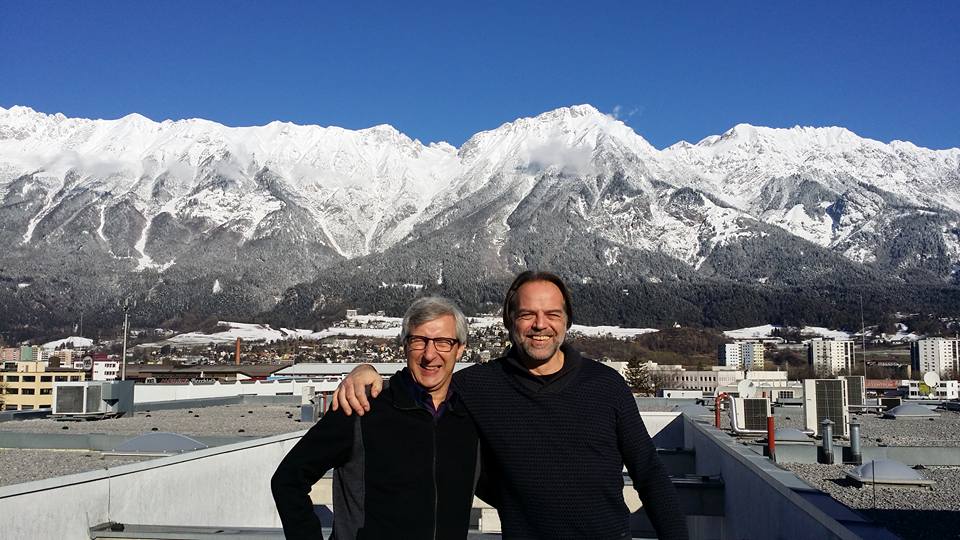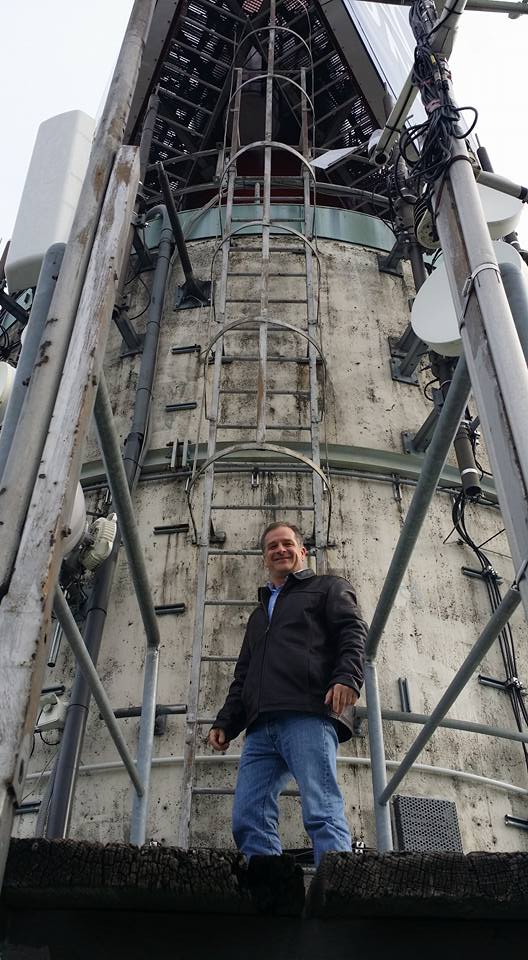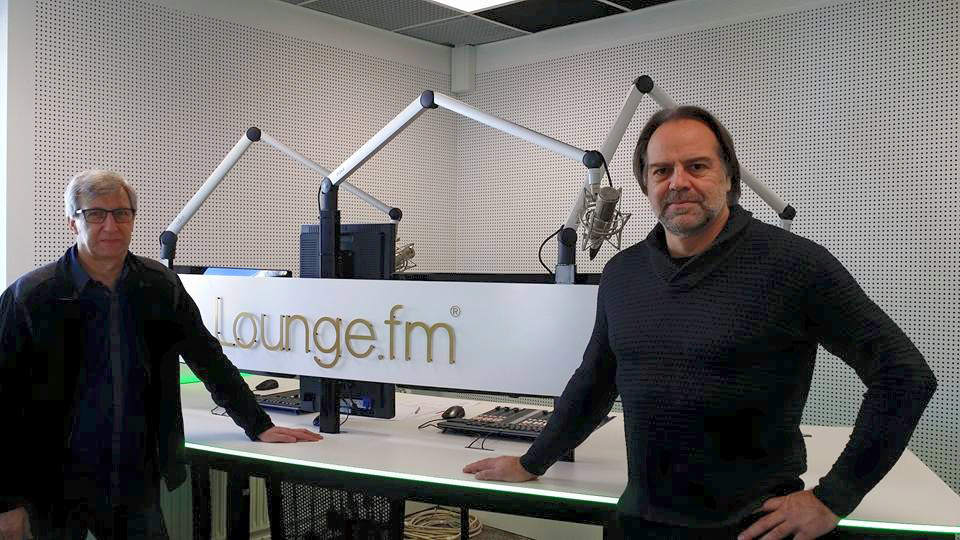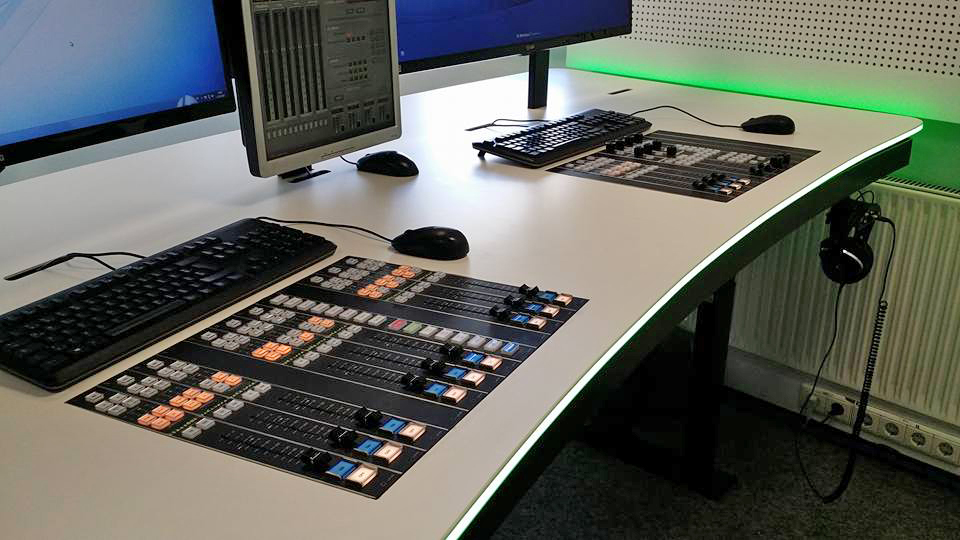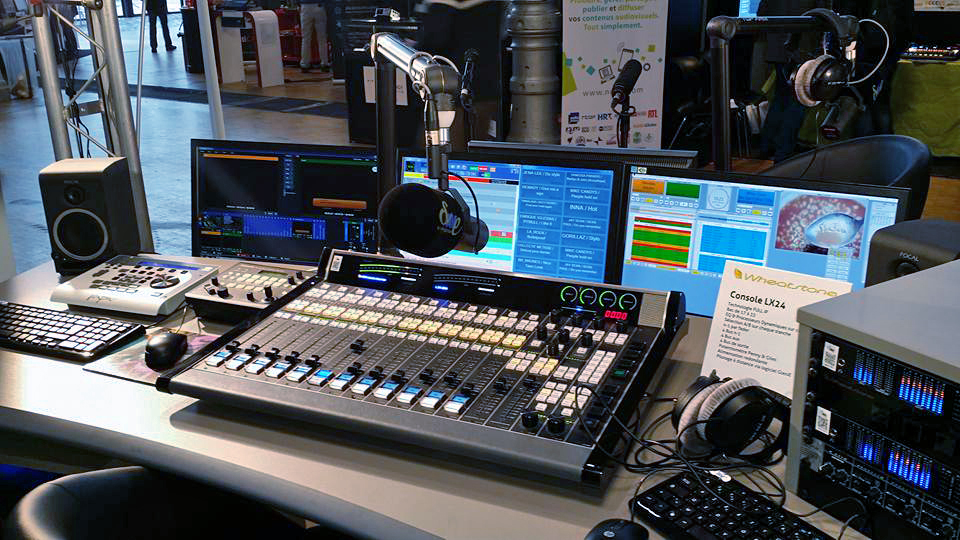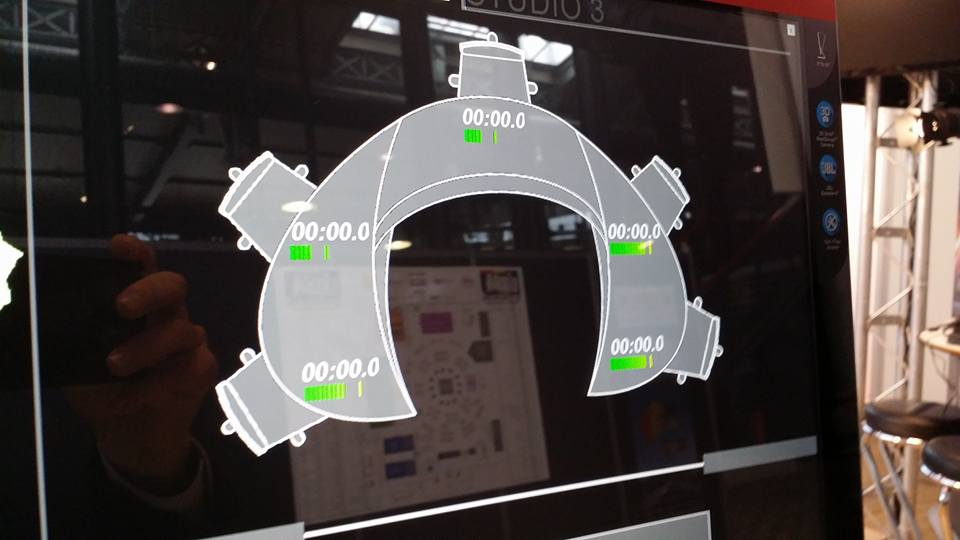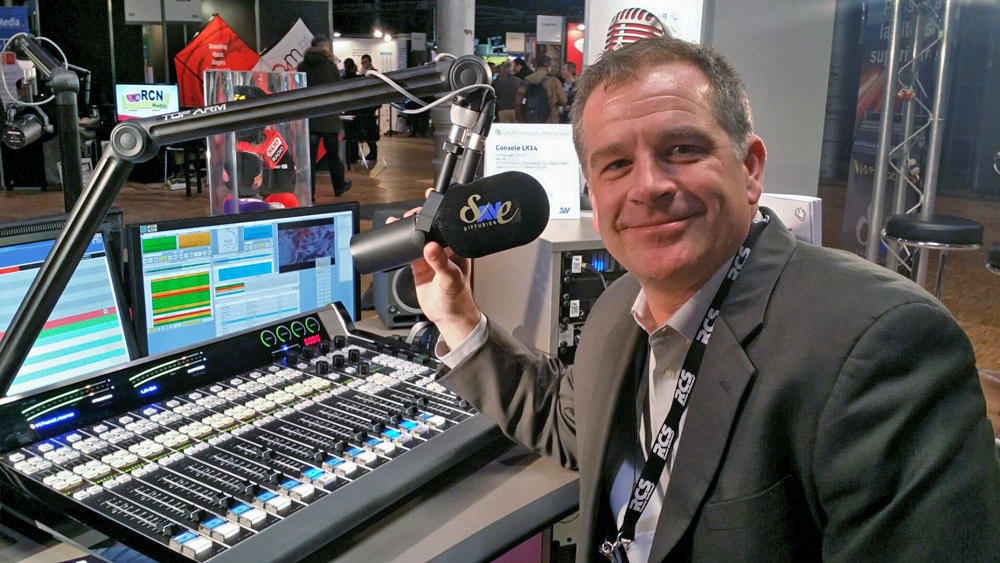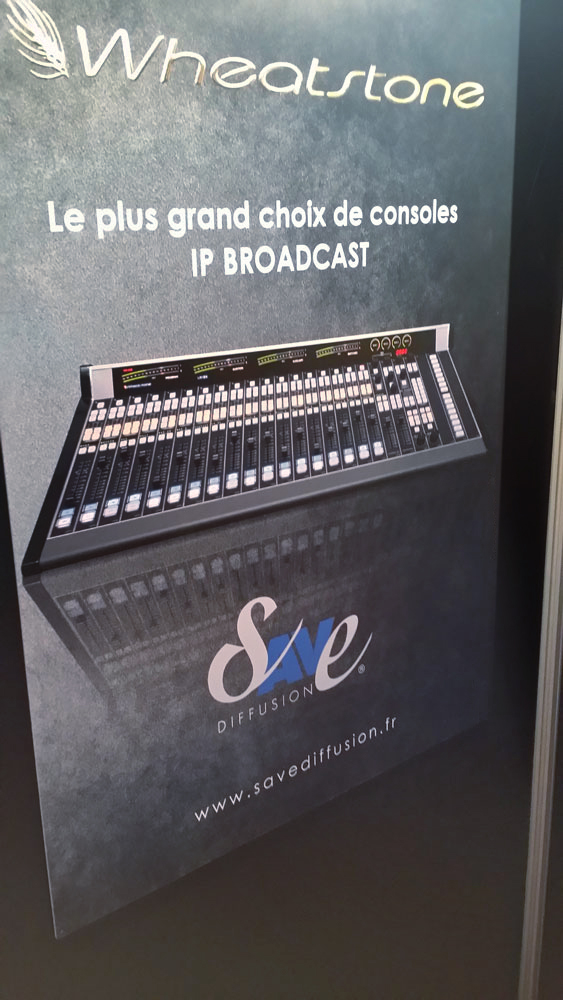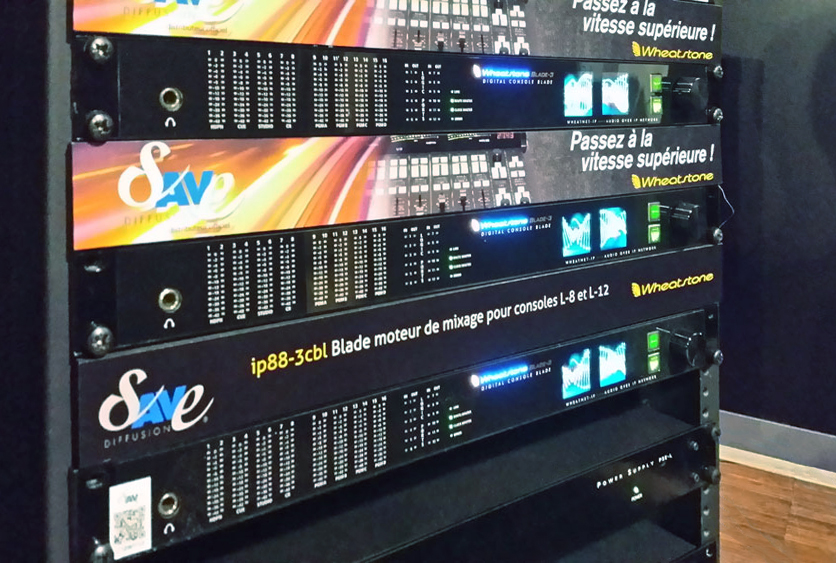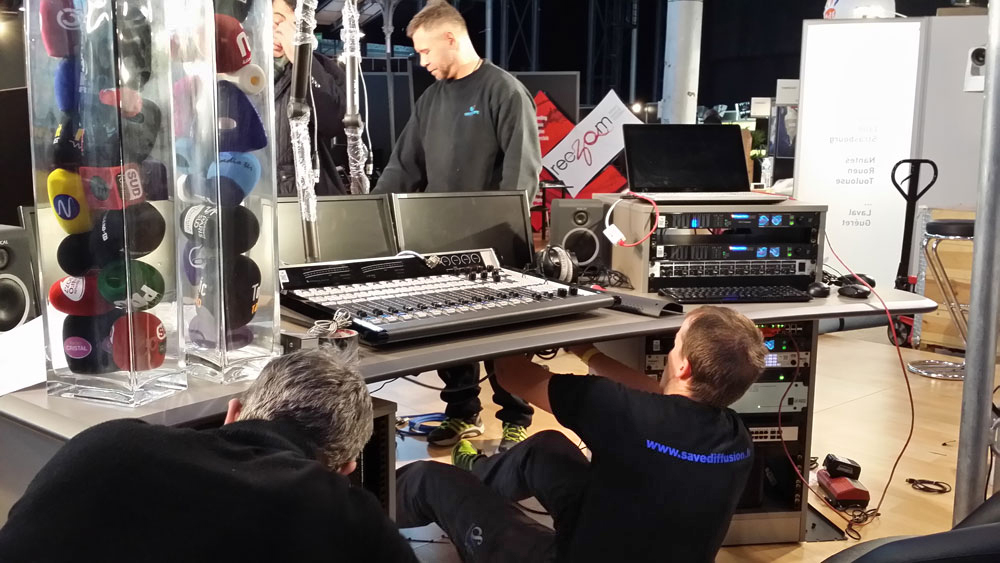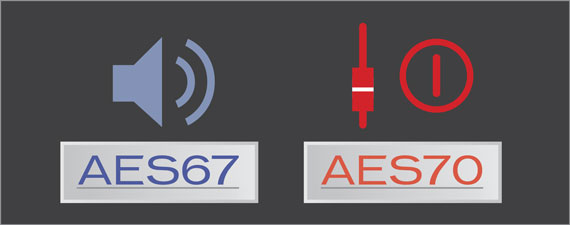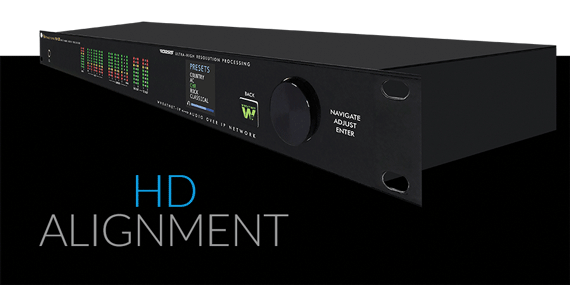WHEAT:NEWS Radio Feb 2016 - Vol 7, No. 2
Got feedback or questions? Click my name below to send us an e-mail. You can also use the links to the right to follow us on popular social networking sites. The tabs at the very top of the page will take you to our most often visited pages.
Go Team Euro!

It’s been an amazing few weeks traveling, working with and getting to know some of the industry’s finest. Here are some pictures of our friends and dealers in Europe, including shots taken at Salon de la Radio 2016 in France, and Welle 1 Studio Innsbruck, Austria. Also, there are a few behind-the-scenes photos of our Jay Tyler, with Markus Stocker and Gerhard Egger of Media Engineering, in Vienna.
MIDI and AES70?
AES70 was ratified on January 4 as a rudimentary control standard for audio IP networking. Whereas AES67 gave us a means to move audio signals from point A to point B regardless of audio network brand, AES70 now offers a basic control standard that we can use to add third-party devices to the WheatNet-IP audio network. Think MIDI, only for the broadcast world.
IP audio network manufacturers have spent a great deal of time, money, and energy developing fully realized solutions that handle intelligent audio transport and control. For example, our WheatNet-IP audio network is a complete studio environment with control surfaces, navigator software, button panels, widget GUIs, audio controllers, and more that interoperate behind the scenes in ways that would give a cellular phone network a run for its money. We can control anything, conditionally if necessary, from just about anywhere in the environment.
AES67 created a basic way to allow non-WheatNet-IP gear to transport audio into and out of the network. Still, without a control standard, audio network manufacturers were limited in their ability to offer inter-platform audio network interoperability.
Now that AES70 has been ratified as an audio IP control standard, how will this change studio operations?
First, it’s important to realize that AES70 will not be adopted overnight. As with all standards, it will take some time before AES70 can be integrated into the studio environment as it is implemented and tested in real world scenarios. Broadcasters should still choose the audio networking system that offers the most complete solution for their needs. AES70 doesn’t change that, but it does promise to facilitate control between third-party devices and an existing environment such as our WheatNet-IP audio network.
Think of AES70 as the MIDI of broadcasting. Just as MIDI was developed as a standard by the music industry to communicate how electronic instruments such as sequencers, keyboards, and processors can control each other, AES70 was developed by audio professionals to communicate basic commands and logic among devices and digital tools in a typical studio environment.
WheatNet-IP will still provide the control you’ll need to be able to seamlessly handle the more complex tasks of connecting faders, knobs, buttons and other software widgets to network hardware, and assigning scripting to widgets through a PC screen to control microphones, consoles and other devices in the network with our Screen Builder software. It will still let you program salvos and macros, control crosspoints, set silence detection, manage failover contingencies, and even completely configure the system from one seat – in real-time. And, as always, WheatNet-IP has built-in logic at each IP connection point that’s shared with other IP connection points across the network. This gives you access to all sources at once as well as the presets and any associated logic that go along with each feed for controlling mic ON/OFF, changing remote settings for IFB, mic preamps, processing and other parameters.
In the WheatNet-IP audio network environment, logic will continue to accompany audio and control, traveling down the same cable, so you can pick up feeds and their logic anywhere along the network. You’ll continue to route any audio input to any or all outputs in the network. You will still be able to easily change remote settings for IFB, switch studios from any console in the network, reconfigure those control surfaces for multiple purposes, and continue to change audio processing settings automatically when, say, a certain mic turns on -- and do that across a great many pieces of equipment at once, even from different facilities miles away.
In case you’re wondering, Wheatstone was part of the AES X210 task force responsible for developing AES70, just as we were part of the task force that developed AES67. (We were one of the first to add AES67 compatibility to our WheatNet-IP audio network, by the way.)
Our goal in welcoming AES70 is to provide users the means to add third party equipment to the WheatNet-IP network, which, when coupled with AES67, will offer the basic control and audio transport functionality for greater studio interoperability.
Check out the newly published AES70-2015 standard for audio applications of networks - Open Control Architecture.
The Drive to Solve Diversity Delay
Automakers are what drive this business. And, they certainly didn’t adopt HD Radio so their customers could complain about the radio not sounding right. Here’s how we solved the diversity delay problem between HD and analog FM signals with the help of our fellow broadcast equipment manufacturers Belar and DaySequerra.
“If Joe Listener takes his car back to the dealer because his HD radio sounds awful, that’s a bad deal all the way around.”
Those are the words of Mike Pappas, Vice President of Business Development for DaySequerra, and they pretty much sum up our worst fear now that HD Radio is seeing some traction. Delay errors between analog and digital signals are becoming more noticeable.
For the most part, HD Radio sounds good. The problem occurs in HD Radio fringe areas where the HD signal starts to blend (transition from HD to analog). If the two signals aren’t time-aligned perfectly, the result is “skipping” or “stuttering” audio as the radio switches from digital to analog (and back again).
What if we could align the analog and HD signals before they reached the receiver by monitoring the signals and automatically correcting the delay? That, in fact, is exactly what we had facilitated last year when we announced a time alignment solution involving Belar’s modulation monitor and our audio processors.
We have since worked with DaySequerra to bring this time alignment solution to its M4.2 TimeLock™ HD Radio receiver using our audio processors.
How HD/Analog Alignment Works
Belar’s FMHD-1 mod monitor or DaySequerra’s M4.2 TimeLock HD receiver continuously measure FM/HD time alignment and transmit diversity delay corrections to our Wheatstone on-air processor through our Automation Control Interface (ACI). ACI is a Wheatstone control protocol that we use to set parameters and make adjustments to our WheatNet-IP audio network as well as our processors though an Ethernet port. In this case, ACI talks to the FMHD-1 mod monitor or M4.2 TimeLock HD receiver. When the FMHD-1 or M4.2 detects a misalignment between the two signals, it communicates to the Wheatstone audio processor through ACI and instructs it to correct the misalignment via the processor’s built-in diversity delay. The end result is a consistent and seamless HD blend to analog whenever HD Radio coverage is less than robust.
We hope every station that has a Wheatstone AirAura X3, FM-531HD, VP-8IP or FM-55 audio processor and a Belar FMHD-1 or DaySequerra M4.2 TimeLock HD receiver will enable this diversity delay option. If you haven’t done so yet, talk to our customer support department regarding a no-cost firmware update for our processors (call 252-638-7000 or email [email protected]) and contact Belar and DaySequerra to find out what changes are needed to enable diversity delay correction in their products.

Wheatstone
- Corus Entertainment (Peterborough, ON) purchased two E-1 control surfaces and I/O BLADEs as well as Glass E virtual mixer and audio drivers for an existing WheatNet-IP audio network.
- Rogers Broadcasting (Toronto, ON) added an EDGE network unit and audio storage/playback and drivers to an existing WheatNet-IP audio network.
- CISF-FM (Surrey, BC) purchased two IP-12 digital audio consoles, an E-1 control surface with Glass E virtual mixer and two M2 dual channel mic processors.
- Cogeco Difussion (Laval, QC) purchased an L-8 control surface for an existing WheatNet-IP audio network.
- CKQB-FM (Ottawa, ON) added an I/O BLADE and NAVIGATOR software upgrade for an existing WheatNet-IP audio network.
- Laura Ingraham (Washington, DC) purchased an IP-12 digital audio console, an M4-IP four channel mic processor BLADE, a TS-4 talent station, several GP panels and software drivers and NAVIGATOR software upgrade.
- CBC (Toronto, ON) purchased two MADI I/O BLADEs.
- Blackburn Radio (Wingham, ON) purchased three Screen Builder apps and upgraded to the new NAVIGATOR software.
- Rogers Broadcasting (Winnipeg, MB) purchased an I/O BLADE for an existing WheatNet-IP audio network.
- Rogers Broadcasting (London, ON) purchased an IP-12 digital audio console.
- Corus Entertainment (Cornwall, ON) upgraded to the new NAVIGATOR software and added new drivers and router controller for an existing WheatNet-IP audio network.
- Blackburn Radio (Sarnia, ON) purchased an E-1 control surface.
- Zoe Communications (Eau Claire, WI) purchased an Aura8-IP eight-processor BLADE and L-12 control surface.
- Hubbard Broadcasting (Phoenix, AZ) added I/O BLADEs to an existing WheatNet-IP audio network.
- CKUA-FM (Calgary, AB) purchased an IP-12 digital audio console and L-12 control surface for an existing WheatNet-IP audio network.
- Leighton Broadcasting (Fergus Falls, MN) added two I/O BLADEs to an existing WheatNet-IP network.
- Bell Media (Gatineau, QC) purchased two SideBoard control surfaces.
- Leighton Broadcasting (Perham, MN) purchased an IP-16 digital audio console.
- HP Services (Toronto, ON) purchased an EDGE network unit.
- Durham Radio (Oshawa, ON) purchased two SideBoard control surfaces.
- CBC (Iqaluit, NU) purchased 13 I/O BLADEs as part of a WheatNet-IP audio network.
- Good Karma Broadcasting (West Palm Beach, FL) purchased an IP-12 and two IP-16 digital audio consoles for a new studio build-out.
- Meredith station WGGB -TV (Springfield, MA) purchased a D-8EX audio console for a second control room combining with an existing control room with D-8EX console.
- Sinclair’s WSTM-TV (Syracuse, NY) purchased a Glass E virtual mixer for an existing WheatNet-IP audio network.
- Oregon Public Broadcasting (Portland) added a MADI interface to an existing TDM router for future IP interface.
- Newsweb Radio (Chicago, IL) purchased an IP-12 digital audio console.
- Curtis Media (Raleigh, NC) purchased an IP-12 digital audio console.
- Bauer Media (Oslo, Norway) purchased MADI and I/O BLADEs as well as audio drivers for an automation upgrade.
- Entravision (Los Angeles, CA) purchased two L-8 control surfaces with BLADEs to expand an existing WheatNet-IP audio network.
- RTE Ireland (Dublin) purchased four additional I/O BLADEs as part of a WheatNet-IP audio network expansion.
- Ocala Broadcasting (Ocala, FL) purchased an IP-12 digital audio console for an existing WheatNet-IP audio network.
- U1 Radio (Schwarz, Austria) purchased E-1 and LX-24 control surfaces with I/O and mic processor BLADEs as part of a WheatNet-IP audio network.
Audioarts Engineering
- Alabama State University (Montgomery) purchased an R-55e console.
- WAAC-FM (Valdosta, GA) purchased an R-55e audio console.
- Bayshore Broadcast (Owen Sound, ON) purchased an Air-1 console.
- Markel Communications purchased an R-55e console.
Wheatstone Audio Processing
- KSE Radio (Denver, CO) purchased two FM-55 audio processors.
- WXLO-FM (Boston, MA) purchased four M2 dual channel mic processors and a VoxPro 5 digital recorder/editor.
- Beasley Broadcast (New Bern, NC) purchased an M1 mic processor.
- Corus Entertainment (Ottawa, ON) purchased a FM-55 audio processor.
- Leighton Broadcasting (St. Cloud, MN) purchased three FM-55 audio processors and a TS-4 talent station.
- Leighton Broadcasting (Perham, MN) purchased an FM-55 audio processor.
- Bell Media (Ottawa, ON) purchased an AM-55 audio processor.
- Rogers Broadcasting (Kingston, ON) purchased ten M1 mic processors.
- CKNO-FM (Edmonton, AB) purchased an M1 mic processor.
- Leighton Broadcasting (St. Cloud, MN) purchased two FM-55 and AM-55 audio processors.
- CHLC-FM (Baie-Comeau, QC) purchased an FM-55 audio processor.
VoxPro
- Rogers Broadcasting (Toronto, ON) upgraded three VoxPro 5 digital recorders/editors.
- iHeartMedia (Seattle, WA) purchased a VoxPro 5 digital recorder/editor.
- Saga Communications (Des Moines, IA) purchased a VoxPro 5 digital recorder/editor.
- iHeartMedia (Los Angeles, CA) purchased three VoxPro 5 digital recorder/editors.
- Bell Media (Montreal, QC) purchased two VoxPro 5 digital recorder/editors.
- Sirius XM Radio (New York, NY) purchased a VoxPro 5 digital recorder/editor.
He'd Tell You, But Then He'd Have to, Well, You Know...
You know your audio processor is doing a good job when the engineer says he can’t disclose the settings because he doesn’t want them to leak out to his competition. We expect that with our AirAura, FM-55 and other Wheatstone processors. But with an I/O BLADE that connects together our WheatNet-IP audio network?

That’s what they’re telling us. To wit: “I don’t want to tell the world what we’re doing, but I can tell you we’re using one of your streaming presets as our starting point,” said Cris Alexander, the DOE for Crawford Broadcasting.
He’s referring to our BLADE-3s, which serve as I/O connection points in the WheatNet-IP network but also happen to have powerful audio processing on board. Ever the budget-conscious engineer, Cris installed the BLADE-3s as part of the WheatNet-IP system (with E-6 control surfaces) and then assigned them double duty as the processing for web streams. He is using BLADE-3s for processing streams in five markets --- Crawford’s clusters in Denver, Detroit, Birmingham, Chicago and Los Angeles – for a total of 14 streams. We’re talking a very diverse group of formats that range from talk to urban.
Each I/O BLADE-3 has a 4-band parametric equalizer, 3-way crossover, 3 compressors, 3 limiters, and final look-ahead limiter, which Cris set up for the station streams from his laptop using our GUI interface. He tapped the music directly from the network using WheatNet-IP audio drivers, processed the audio through the processing functions in the BLADE-3 and sent it on as a 64kbps stream. He eliminated the use of outboard audio processing, as well as any AD/DA conversion needed for streaming. He consolidated streams in each market into a single enterprise-grade rack mount PC. Using WheatNet-IP drivers instead of sound cards made it fairly straightforward to do.
By the way, this is the group we told you about previously that’s using the WheatNet-IP audio network and Tieline Genie to distribute the Bob Dutko show and other programming across the country over the Internet. Click here.
As for the EQ and other processor settings on those streams, we know nothing.
Side Note on Streaming
If you haven’t seen it yet, we suggest you take a look at the new AES Recommendation for Loudness of Audio Streaming and Network File Playback. You’ll find some helpful guidelines for processing web streams.
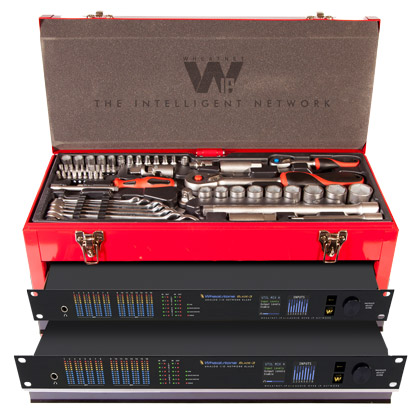
Your Question Answered
Q: Why is a distributed network like the WheatNet-IP better for redundancy than a centralized system?
A: Centralizing network management is a single-point-of-failure waiting to happen, whereas distributing network resources to every IP point naturally builds in redundancy. If one part of the network fails for any reason, the rest can keep on functioning. Each IP connection point (or WheatNet-IP BLADE) stores the entire configuration of the network onboard, which means that failover is immediate. And because WheatNet-IP BLADEs talk to each other, adding additional BLADEs onto the network is plug-and-play for easy system expansion.
Wheatstone On The Road

Wheatstone will be in London, 23-25 February, for the BV Expo in London, England at Wheatstone Stand F26 and Boxer Stand K06


